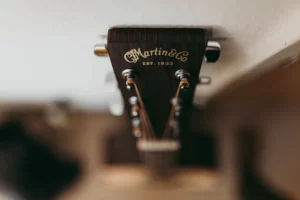- How to Measure a Guitar
- Measuring a Guitar’s Total Length
- The best way to compare guitars is by their scale length
- Measuring a Guitar’s Scale Length
- Size of a ‘full size’ guitar?
- What are the different sizes of guitars?
- What size guitar does a child need?
- Should you buy a full-sized guitar for your child?
- My Experience
Many questions arise when it comes to deciding on a guitar. What size should you get? Will this make me better at playing the instrument, or is there something else involved in choosing one for myself, such as personal preference and comfort level with handling certain guitar sizes/shapes (i am not saying any)? The answer can be found within these guidelines, but first, let’s take inventory of all potential buyers so we know how many types our market has!
How to Measure a Guitar
Let’s first look at how to measure a guitar. Knowing how is important because it can help you compare different guitars more accurately, and for that reason, I recommend measuring the scale length over just taking its total length! Before we get started, though – what exactly do we mean when talking about “guitar size?” There are two main ways: either from end-to-end or by looking at something called “scaled lengths.” Measuring both will give us an idea if our purchase was worth spending money on… But knowing only one may not always suffice, especially since they differ in importance depending on whether someone wants their playing abilities improved overall (total) instead of focusing specifically on improving specific parts within solos/parts played.
There are three main parts of every guitar, as highlighted below:
- The headstock
- The neck
- The body
Whether you purchase an acoustic guitar or electric, every music-making machine has three basic parts. The only exception is when it’s without a headstock on the instrument – these guitars can be called “headless” and come in many different styles!
Measuring a Guitar’s Total Length
Guitar bodies come in all shapes and sizes, which means there’s no single way to measure their total lengths. However! I was able to find some common trends when exploring this topic online – like how jazz boxes tend to be longer than standard guitars due to their extra features such as tremolo bridges or electronics cavities inside the body (for sound production). Now go out into your garage with a tape measure ready because we need some hard data on exactly where these numbers come from.
Best way to compare guitars is by their scale length
We all know how important good tone-quality electronics are when playing an electric guitar; so it makes sense then why some people would prefer longer scales over shorter ones – since they offer more options regarding performance style (since everything from distortion effects right down picking technique changes).
Measuring a Guitar’s Scale Length
The best way to compare guitars is by their scale length. Some brands have long headstocks, while others have short ones, and that can throw off measurements if you’re trying to find the perfect fit for your hands or whatever else might be going on in there!
Size of a ‘full size’ guitar?
Even though the term ‘full size’ guitars can cause some confusion, there are a few things you should know. For example, each type of guitar (e.g., classical dreadnought) has its standard size that varies depending on brand and model- but they’re all relative! You can tell which type of guitar it is by checking if its scales are longer than 25″. If so, then this means they’re probably full-size guitars! Scaled-down guitars like 3/4 and 1-octave models exist for many different purposes.
The smaller-sized guitar is intended for people who have trouble carrying around their full-size instrument. They’re also great if you want your child to learn how to play an actual instrument without having them practice on something too big that’s not always reliable or easy enough when it comes to time; put in some serious hours at home practising! The scaled-down version of this type will feel very different than what most adults are used to playing due to its shorter length coupled with reduced scale lengths but still has plenty of sound quality, all things considered, so don’t worry yourself over stuff like those issues plus they make fantastic travel guitars.
How you choose your instrument will slightly depend on the type of music that’s easiest. A full-size guitar will typically have more string length than an electric one, but if they’re both tuned similarly, then it should feel about equally comfortable regardless; however, some people might find themselves better suited towards certain shapes or styles due to their physical traits like size hands etcetera.
A dreadnought acoustic guitar and Les Paul electric usually both measure around 36 inches when fully stretched out with different scale lengths making them respective appropriate sizes depending upon desired tone quality.
What are the different sizes of guitars?
A guitar is a beautiful, resonant instrument that has been played by some of the most iconic musicians in history. While there are many different types and sizes for acoustic guitars out on today’s market – from full-sized classical guitars all the way down to 3/4 inch mini versions known as “tuners”- let’s have a look at how knowing what kind you need can help make finding one easier!
The four common systems include:
Full-Size Acoustic Guitar This would be something like an old fashioned Sears catalogue model, also called a 4/4 sized guitar which is your typical full-sized guitar.
While you would expect a 1/2 size guitar to be half the size of its full-sized counterpart, this is not always true. The naming system used for acoustic guitars can be very misleading, and it’s easy to mistake them in stores when they’re much smaller than what you thought!
You might be surprised to learn that a 1/4 guitar is not the same size as your typical full-sized acoustic. A scale length of 19 inches (48 cm) and a total of 31 inches (78cm) make them much smaller than what most people think!

There are three types: 1/2, 3/4 & 7 / 8 instruments which have different names to simplify matters but don’t match up with their actual sizes exactly – no need for confusion here, though because they all sound glorious when played by great musicians like yourself who know how important music can be during tough times or just everyday life.
What size guitar does a child need?
To make the guitar easier for your child, look at what size they need. Full-sized Dreadnought acoustic guitars can be too big and overwhelming for a small kid to play in general, so if you’re not sure which one is right or how much space I’ll have on my shelf, let me know! 1/2 & 3/4 sized instruments are smaller than full scale but still provide enough reach over body parts that make it easy as pie (or should we say “guitar”).
Here are some general rules-of-thumb on what size guitar to get for children:
- 1/4 sized or ukulele: up to 5 years old
- 1/2 sized: 5-7 years old
- 3/4 sized: 7-10 years old
- Full-sized: 10 years and older
The above recommendations are quite different from the typical advice you see on other websites. As I’ll explain below, I recommend buying a guitar a bit bigger than what you think you should get.
Important: Think of buying a guitar like buying shoes for your child. Children grow rapidly, and something that looks like the perfect fit today can quickly become too small when they get older, so it’s wise to buy them an extra-large size just in case! While this may not be their ‘ideal’ instrument at any point during development (and who knows what will happen!), you ensure they won’t outgrow their current one quite yet, ultimately keeping peace within family homes by preventing arguments over whose turn it is playing music.
Should you buy a full-sized guitar for your child?
It may seem like the best option would be to buy your child a scaled-down guitar, but there’s another choice. You can purchase an entire full-sized musical instrument for them as well – this will allow you both more flexibility in terms of where and how often they practice their skills without ever having too many guitars around at once! The downside? They might not outgrow it either, so consider getting two smaller ones instead if that’s something important.
My 9-year-old daughter is an amazing guitarist – but she wouldn’t be without her full-sized guitar. I would never recommend a 1/4 or 1/2 sized guitar for children under around 7, so if your child’s age indicates they’re ready to move up from toys, then get them something on the cheap end.
Full-sized acoustic guitars can be a major obstacle for young children. A full-sized dreadnought guitar (steel string) is the worst type of instrument because it has such a large body that your kid may not fit comfortably on this large size, and even if they do, there’s no way you’ll find them appealing when compared with other instruments like keyboards!
The solution? Choose between classical or nylon strings depending upon what kind of tone quality sounds better in regards to music theory topics being learned at school/home – those studying jazz should go with nylon since their teacher prefers brighter sounding notes while rock n’ roll fans require something heavier feeling around the neck- level, so as long fingers don’t get too far away from the fretboard.
My Experience
I started learning guitar at the age of 7 on a full-sized electric guitar. Looking back at photos, I can see that it was too big for me when we shot them but not then – now all those years later and with no memory or frustration from feeling frustrated about its size! I’m glad I got started with one like mine because even though you might think these are minor details, every little thing counts over time – especially something as important as your first instrument, which will always be special to remember in life.
Starting a child on an electric guitar is better because they can learn faster and have more fun. They don’t need to worry about managing with the larger size, which means you won’t see them giving up Learning the instrument after just one day! Plus, if your little rock star wants their full-sized steel-string acoustic later down the line (or even before), there are plenty available now as well–so all’s fair in love & guitars!!







